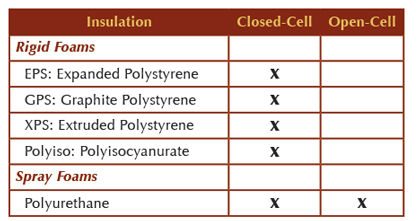When choosing foam insulations, you’re likely to see manufacturers describe their product as either “closed-cell” or “open-cell,” but what does that mean and why does it matter to you?
FOAM INSULATION TYPES
Foam insulations come in two broad types: spray foams and rigid foams.
Spray foam insulation is created on the jobsite by mixing two chemical compounds that react and foam up to fill voids and provide an insulating layer. By contrast, rigid foam insulations are created in a factory and arrive at the jobsite in panel form that provides a thermal barrier. Rigid foam insulations come in numerous product configurations, including faced and un-faced panels.
Rigid foam panels are all closed-cell, while spray foams are either closed- or open-cell, depending on the product. See the chart for the major foam insulations.
UNDER THE MICROSCOPE
All foam insulations are composed of numerous tiny “bubbles” (cells) within a polymer material. If these cells are fully enclosed like an inflated balloon, then the foam is considered to be closed-cell. The open-cell foams have holes in the cells that allow for the blowing agent to dissipate in the foaming process and the holes allow air to act as the insulator.
It is not possible to tell if foam insulation is closed- or open-cell simply by looking at it since the cell configuration is microscopic, but the manufacturer will list what the cell configuration is of their products.

THERMAL PERFORMANCE
If you’re using rigid foam insulation, the closed- versus open-cell question is moot since all available rigid foams are closed-cell. A factor to consider instead is the blowing agent used to produce the foam since that impacts the R-value and the insulation’s long-term thermal stability.
For XPS, polyiso, and closed-cell spray foams, the blowing agent is a gas the manufacturer introduces into a liquid plastic to create a foam via numerous bubbles. As the plastic hardens, the gas is trapped in the bubbles. Blowing agents include various chemical compounds, such as carbon dioxide (CO2), pentanes, and various HCFCs (hydrochlorofluorocarbons), among others.
In addition to creating the foam, the blowing agent can enhance the insulation’s thermal resistance (R-value) when trapped in the cells (but, for some products, the only gas in the cells is air). Despite having completely formed cells in some rigid foams, the blowing agent is replaced with air over time through diffusion. Such is the case with extruded polystyrene (XPS) and polyiso insulations, while expanded polystyrene (EPS) insulations have air trapped in the cells, the R-value does not degrade with time. This matters because if the blowing agent provides a boost to the insulation’s R-value, as it dissipates, the R-value decreases (in other words, the insulation becomes less effective over time at doing its job). This is known as thermal drift.
The best way to determine if insulation will experience thermal drift is to review the manufacturer’s warranty. EPS manufacturers typically warrant 100 percent of their products’ R-values over time, while other rigid foam warranties only cover 80 to 90 percent of the stated R-value.
CONCLUSION
Both spray foams and rigid foams play an important role in building insulation. While each insulation type has its own advantages, the important thing is to do your research and carefully compare performance and cost for your situation, including other factors not discussed, such as moisture absorption rate and compressive resistance. ■
About The Author: Michael McAuley is the president of Insulfoam. McAuley has more than 20 years experience in building material sales and production management, including 14 years at Insulfoam’s sister company, Versico Roofing Systems, as the national sales manager and general manager. For more information, visit www.insulfoam.com.
_________________________________________________________________________
Modern Contractor Solutions – February 2016
Did you enjoy this article?
Subscribe to the FREE Digital Edition of Modern Contractor Solutions magazine.

Making Sense of Closed-cell and Open-cell Insulation


